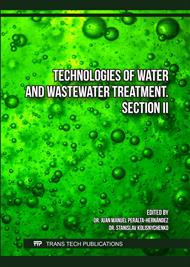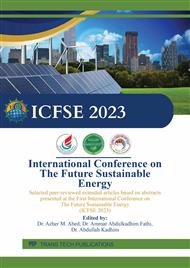[1]
CPCB BULLETIN VOL.-I. JULY 2016. Updated on December 6th, 2016. [Online]. Available from: http://cpcb.nic. in/upload/Latest/Latestç123çSUMMARYçBOOKçFS. Pdf
Google Scholar
[2]
Kaewkannetra P, Chiwes W, Chiu TY. Treatment of cassava mill wastewater and production of electricity through microbial fuel cell technology. Fuel. 2011; 90: 2746–2750. DOI: 10.1016/j.fuel. 2011.03.031.
DOI: 10.1016/j.fuel.2011.03.031
Google Scholar
[3]
Ho IP, Chenjie W, Lian-Shin L. Coal tar wastewater treatment and electricity production using a membrane-less tubular microbial fuel cell. Biotechnol Bioprocess Eng. 2012;17:654–660. DOI:10.1007/s12257- 011-0374-2
DOI: 10.1007/s12257-011-0374-2
Google Scholar
[4]
Potter, M C 1911 Proceedings of the royal society of London. Series b, containing papers of a biological character, 84(571). 260-276.
Google Scholar
[5]
Lewis, K 1966 Bacteriological reviews, 30(1). 101-113.[6] Kim, B H, D H Park, P K Shin, I S Chang and H J Kim 1999 Google Patents, 5976719.
Google Scholar
[7]
Nader, M, R Wan, M Rahimnejad and G Najafpour 2012 World Applied Sciences Journal, 18(4). 559-567.
Google Scholar
[8]
Jana, P.S., Behera, M., Ghangrekar, M.M., 2010. Performance 345 comparison of up-flow microbial fuel cells fabricated using 346 proton exchange membrane and earthen cylinder. Int. 347 J. Hydrog. Energy 35, 5681–5686.
DOI: 10.1016/j.ijhydene.2010.03.048
Google Scholar
[9]
L. Christenson, R. Sims, Production and harvesting of microalgae for wastewater treatment, biofuels, and bioproducts, Biotechnol. Adv. 29 (2011) 686–702, https:// doi.org/10.1016/ j.biotechadv.2011.05.015.
DOI: 10.1016/j.biotechadv.2011.05.015
Google Scholar
[10]
Subha, C., Kavitha, S., Abisheka, S., Tamilarasan, K., Arulazhagan, P., & Banu, J. R. (2019). Bioelectricity generation and effect studies from organic rich chocolaterie wastewater using continuous upflow anaerobic microbial fuel cell. Fuel, 251, 224-232.
DOI: 10.1016/j.fuel.2019.04.052
Google Scholar
[11]
Luo, H., Liu, G., Zhang, R., Bai, Y., Fu, S., & Hou, Y. (2014). Heavy metal recovery combined with H2 production from artificial acid mine drainage using the microbial electrolysis cell. Journal of hazardous materials, 270, 153-159.
DOI: 10.1016/j.jhazmat.2014.01.050
Google Scholar
[12]
Thung, W. E., Ong, S. A., Ho, L. N., Wong, Y. S., Ridwan, F., Oon, Y. L., ... & Lehl, H. K. (2018). Sustainable green technology on wastewater treatment: the evaluation of enhanced single chambered up-flow membrane-less microbial fuel cell. Journal of Environmental Sciences, 66, 295-300.
DOI: 10.1016/j.jes.2017.05.010
Google Scholar
[13]
Tsai, H. Y., Wu, C. C., Lee, C. Y., & Shih, E. P. (2009). Microbial fuel cell performance of multiwall carbon nanotubes on carbon cloth as electrodes. Journal of Power Sources, 194(1), 199-205.
DOI: 10.1016/j.jpowsour.2009.05.018
Google Scholar
[14]
Chaudhuri, S.K. and Lovley, D.R., (2003). Electricity generation by direct oxidation of glucose in mediatorless microbial fuel cells. Nature Biotechnology. Vol. 21, Issue 10, pp.1229-1232.
DOI: 10.1038/nbt867
Google Scholar
[15]
Mansoorian, H.J., Mahvi, A.H., Jafari, A.J., Amin, M.M., Rajabizadeh, A., Khanjani, N. 2013. Bioelectricity generation using two chamber microbial fuel cell treating wastewater from food processing. Enzyme and microbial technology, 52(6), 352-357.
DOI: 10.1016/j.enzmictec.2013.03.004
Google Scholar
[16]
Mahendra, B. and Mahavarkar, S., (2013). Treatment of wastewater and electricity generation using microbial fuel cell technology. International Journal of Research in Engineering and Technology. Vol. 1, Issue 1, pp.277-282.
DOI: 10.15623/ijret.2013.0213050
Google Scholar
[17]
Ali, A.H., et al., (2019). Comparison between conventional and modified microbial fuel cell for wastewater treatment and electricity generation. International Journal of Environmental Science and Technology. Vol.16, Issue 12, pp.8141-8150.
DOI: 10.1007/s13762-019-02355-x
Google Scholar
[18]
Patade S, Silveira K, Babu A, D'Costa F, Mhatre Y, Saini V, Rajput R, Mathew J, Radhika BR, Aruna K (2016) Bioremediation of dye efuent waste through an optimized microbial fuel cell. Int J Adv Res Biol Sci 3(5):214–226
Google Scholar
[19]
Khan MR, Bhattacharjee R, Amin MSA (2012) Performance of the salt bridge based microbial fuel cell. Int J Eng Technol 1(2): 115–123
Google Scholar




